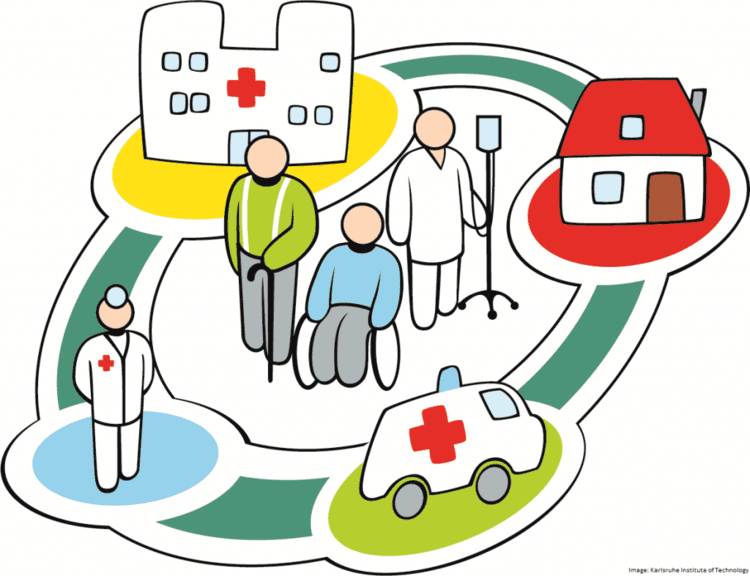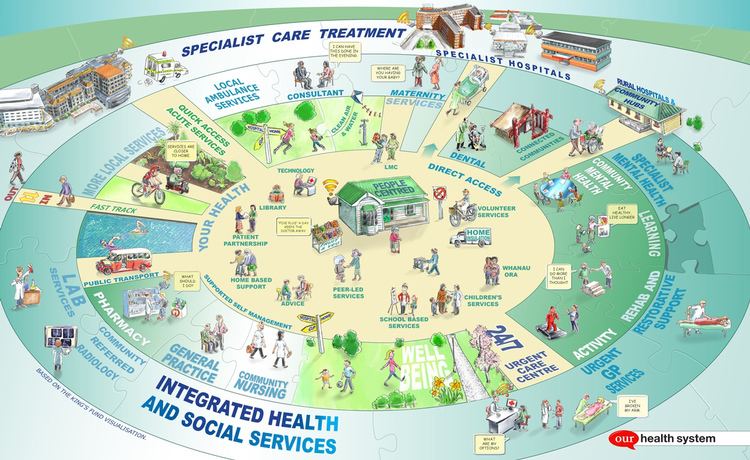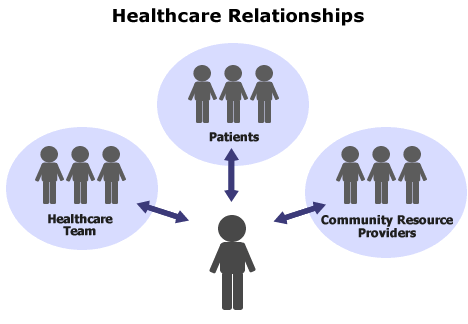 | ||
A health system, also sometimes referred to as health care system or as healthcare system, is the organization of people, institutions, and resources that deliver health care services to meet the health needs of target populations.
Contents
- Goals
- Definitions
- World Health Organization definition
- Providers
- Management
- Health systems performance
- International comparisons
- References

There is a wide variety of health systems around the world, with as many histories and organizational structures as there are nations. Implicitly, nations must design and develop health systems in accordance with their needs and resources, although common elements in virtually all health systems are primary healthcare and public health measures. In some countries, health system planning is distributed among market participants. In others, there is a concerted effort among governments, trade unions, charities, religious organizations, or other co-ordinated bodies to deliver planned health care services targeted to the populations they serve. However, health care planning has been described as often evolutionary rather than revolutionary.

Goals
The World Health Organization (WHO), the directing and coordinating authority for health within the United Nations system, is promoting a goal of universal health care: to ensure that all people obtain the health services they need without suffering financial hardship when paying for them. According to WHO, healthcare systems' goals are good health for the citizens, responsiveness to the expectations of the population, and fair means of funding operations. Progress towards them depends on how systems carry out four vital functions: provision of health care services, resource generation, financing, and stewardship. Other dimensions for the evaluation of health systems include quality, efficiency, acceptability, and equity. They have also been described in the United States as "the five C's": Cost, Coverage, Consistency, Complexity, and Chronic Illness. Also, continuity of health care is a major goal.
Definitions

Often health system has been defined with a reductionist perspective, for example reducing it to healthcare system. In many publications, for example, both expressions are used interchangeably. Some authors have developed arguments to expand the concept of health systems, indicating additional dimensions that should be considered:

World Health Organization definition
The World Health Organization defines health systems as follows:

A health system consists of all organizations, people and actions whose primary intent is to promote, restore or maintain health. This includes efforts to influence determinants of health as well as more direct health-improving activities. A health system is therefore more than the pyramid of publicly owned facilities that deliver personal health services. It includes, for example, a mother caring for a sick child at home; private providers; behaviour change programmes; vector-control campaigns; health insurance organizations; occupational health and safety legislation. It includes inter-sectoral action by health staff, for example, encouraging the ministry of education to promote female education, a well known determinant of better health.
Providers
Healthcare providers are institutions or individuals providing healthcare services. Individuals including health professionals and allied health professions can be self-employed or working as an employee in a hospital, clinic, or other health care institution, whether government operated, private for-profit, or private not-for-profit (e.g. non-governmental organization). They may also work outside of direct patient care such as in a government health department or other agency, medical laboratory, or health training institution. Examples of health workers are doctors, nurses, midwives, dietitians, paramedics, dentists, medical laboratory technologists, therapists, psychologists, pharmacists, chiropractors, optometrists, community health workers, traditional medicine practitioners, and others.
Management
The management of any health system is typically directed through a set of policies and plans adopted by government, private sector business and other groups in areas such as personal healthcare delivery and financing, pharmaceuticals, health human resources, and public health.
Public health is concerned with threats to the overall health of a community based on population health analysis. The population in question can be as small as a handful of people, or as large as all the inhabitants of several continents (for instance, in the case of a pandemic). Public health is typically divided into epidemiology, biostatistics and health services. Environmental, social, behavioral, and occupational health are also important subfields.
Today, most governments recognize the importance of public health programs in reducing the incidence of disease, disability, the effects of ageing and health inequities, although public health generally receives significantly less government funding compared with medicine. For example, most countries have a vaccination policy, supporting public health programs in providing vaccinations to promote health. Vaccinations are voluntary in some countries and mandatory in some countries. Some governments pay all or part of the costs for vaccines in a national vaccination schedule.
The rapid emergence of many chronic diseases, which require costly long-term care and treatment, is making many health managers and policy makers re-examine their healthcare delivery practices. An important health issue facing the world currently is HIV/AIDS. Another major public health concern is diabetes. In 2006, according to the World Health Organization, at least 171 million people worldwide suffered from diabetes. Its incidence is increasing rapidly, and it is estimated that by the year 2030, this number will double. A controversial aspect of public health is the control of tobacco smoking, linked to cancer and other chronic illnesses.
Antibiotic resistance is another major concern, leading to the reemergence of diseases such as tuberculosis. The World Health Organization, for its World Health Day 2011 campaign, is calling for intensified global commitment to safeguard antibiotics and other antimicrobial medicines for future generations.
Health systems performance
Since 2000, more and more initiatives have been taken at the international and national levels in order to strengthen national health systems as the core components of the global health system. Having this scope in mind, it is essential to have a clear, and unrestricted, vision of national health systems that might generate further progresses in global health. The elaboration and the selection of performance indicators are indeed both highly dependent on the conceptual framework adopted for the evaluation of the health systems performances. Like most social systems, health systems are complex adaptive systems where change does not necessarily follow rigid epidemiological models. In complex systems path dependency, emergent properties and other non-linear patterns are under-explored and unmeasured, which can lead to the development of inappropriate guidelines for developing responsive health systems.
An increasing number of tools and guidelines are being published by international agencies and development partners to assist health system decision-makers to monitor and assess health systems strengthening including human resources development using standard definitions, indicators and measures. In response to a series of papers published in 2012 by members of the World Health Organization's Task Force on Developing Health Systems Guidance, researchers from the Future Health Systems consortium argue that there is insufficient focus on the 'policy implementation gap'. Recognizing the diversity of stakeholders and complexity of health systems is crucial to ensure that evidence-based guidelines are tested with requisite humility and without a rigid adherence to models dominated by a limited number of disciplines.
Health Policy and Systems Research (HPSR) is an emerging multidisciplinary field that challenges 'disciplinary capture' by dominant health research traditions, arguing that these traditions generate premature and inappropriately narrow definitions that impede rather than enhance health systems strengthening. HPSR focuses on low- and middle-income countries and draws on the relativist social science paradigm which recognises that all phenomena are constructed through human behaviour and interpretation. In using this approach, HPSR offers insight into health systems by generating a complex understanding of context in order to enhance health policy learning. HPSR calls for greater involvement of local actors, including policy makers, civil society and researchers, in decisions that are made around funding health policy research and health systems strengthening.
International comparisons
Health systems can vary substantially from country to country, and in the last few years, comparisons have been made on an international basis. The World Health Organization, in its World Health Report 2000, provided a ranking of health systems around the world according to criteria of the overall level and distribution of health in the populations, and the responsiveness and fair financing of health care services. The goals for health systems, according to the WHO's World Health Report 2000 – Health systems: improving performance (WHO, 2000), are good health, responsiveness to the expectations of the population, and fair financial contribution. There have been several debates around the results of this WHO exercise, and especially based on the country ranking linked to it, insofar as it appeared to depend mostly on the choice of the retained indicators.
Direct comparisons of health statistics across nations are complex. The Commonwealth Fund, in its annual survey, "Mirror, Mirror on the Wall", compares the performance of the health systems in Australia, New Zealand, the United Kingdom, Germany, Canada and the United States Its 2007 study found that, although the United States system is the most expensive, it consistently underperforms compared to the other countries. A major difference between the United States and the other countries in the study is that the United States is the only country without universal health care. The OECD also collects comparative statistics, and has published brief country profiles. Health Consumer Powerhouse makes comparisons between both national health care systems in the Euro health consumer index and specific areas of health care such as diabetes or hepatitis.
Physicians and hospital beds per 1000 inhabitants vs Health Care Spending in 2008 for OECD Countries. The data source is http://www.oecd.org.
